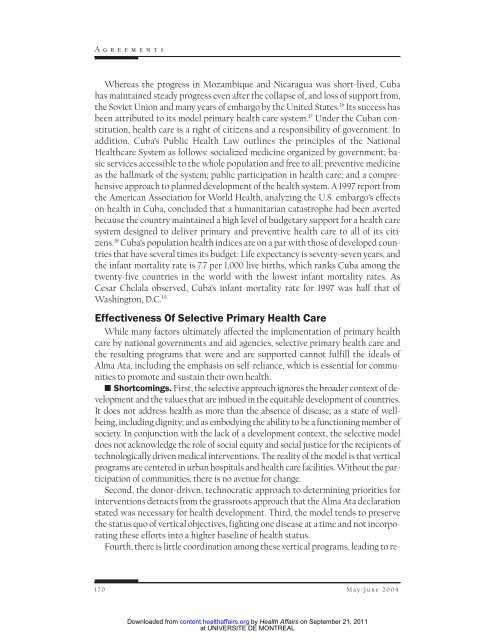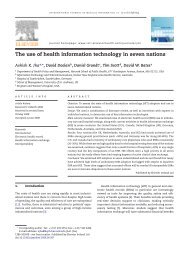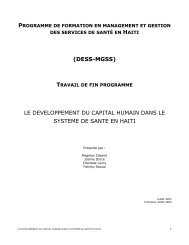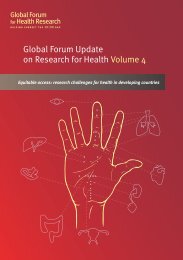At the Intersection of Health, Health Care and Policy doi: 10.1377 ...
At the Intersection of Health, Health Care and Policy doi: 10.1377 ...
At the Intersection of Health, Health Care and Policy doi: 10.1377 ...
- No tags were found...
You also want an ePaper? Increase the reach of your titles
YUMPU automatically turns print PDFs into web optimized ePapers that Google loves.
AgreementsWhereas <strong>the</strong> progress in Mozambique <strong>and</strong> Nicaragua was short-lived, Cubahas maintained steady progress even after <strong>the</strong> collapse <strong>of</strong>, <strong>and</strong> loss <strong>of</strong> support from,<strong>the</strong> Soviet Union <strong>and</strong> many years <strong>of</strong> embargo by <strong>the</strong> United States. 16 Its success hasbeen attributed to its model primary health care system. 17 Under <strong>the</strong> Cuban constitution,health care is a right <strong>of</strong> citizens <strong>and</strong> a responsibility <strong>of</strong> government. Inaddition, Cuba’s Public <strong>Health</strong> Law outlines <strong>the</strong> principles <strong>of</strong> <strong>the</strong> National<strong>Health</strong>care System as follows: socialized medicine organized by government; basicservices accessible to <strong>the</strong> whole population <strong>and</strong> free to all; preventive medicineas <strong>the</strong> hallmark <strong>of</strong> <strong>the</strong> system; public participation in health care; <strong>and</strong> a comprehensiveapproach to planned development <strong>of</strong> <strong>the</strong> health system. A 1997 report from<strong>the</strong> American Association for World <strong>Health</strong>, analyzing <strong>the</strong> U.S. embargo’s effectson health in Cuba, concluded that a humanitarian catastrophe had been avertedbecause <strong>the</strong> country maintained a high level <strong>of</strong> budgetary support for a health caresystem designed to deliver primary <strong>and</strong> preventive health care to all <strong>of</strong> its citizens.18 Cuba’s population health indices are on a par with those <strong>of</strong> developed countriesthat have several times its budget: Life expectancy is seventy-seven years, <strong>and</strong><strong>the</strong> infant mortality rate is 7.7 per 1,000 live births, which ranks Cuba among <strong>the</strong>twenty-five countries in <strong>the</strong> world with <strong>the</strong> lowest infant mortality rates. AsCesar Chelala observed, Cuba’s infant mortality rate for 1997 was half that <strong>of</strong>Washington, D.C. 19Effectiveness Of Selective Primary <strong>Health</strong> <strong>Care</strong>While many factors ultimately affected <strong>the</strong> implementation <strong>of</strong> primary healthcare by national governments <strong>and</strong> aid agencies, selective primary health care <strong>and</strong><strong>the</strong> resulting programs that were <strong>and</strong> are supported cannot fulfill <strong>the</strong> ideals <strong>of</strong>Alma <strong>At</strong>a, including <strong>the</strong> emphasis on self-reliance, which is essential for communitiesto promote <strong>and</strong> sustain <strong>the</strong>ir own health. Shortcomings. First, <strong>the</strong> selective approach ignores <strong>the</strong> broader context <strong>of</strong> development<strong>and</strong> <strong>the</strong> values that are imbued in <strong>the</strong> equitable development <strong>of</strong> countries.It does not address health as more than <strong>the</strong> absence <strong>of</strong> disease; as a state <strong>of</strong> wellbeing,including dignity; <strong>and</strong> as embodying <strong>the</strong> ability to be a functioning member <strong>of</strong>society. In conjunction with <strong>the</strong> lack <strong>of</strong> a development context, <strong>the</strong> selective modeldoes not acknowledge <strong>the</strong> role <strong>of</strong> social equity <strong>and</strong> social justice for <strong>the</strong> recipients <strong>of</strong>technologically driven medical interventions. The reality <strong>of</strong> <strong>the</strong> model is that verticalprograms are centered in urban hospitals <strong>and</strong> health care facilities. Without <strong>the</strong> participation<strong>of</strong> communities, <strong>the</strong>re is no avenue for change.Second, <strong>the</strong> donor-driven, technocratic approach to determining priorities forinterventions detracts from <strong>the</strong> grassroots approach that <strong>the</strong> Alma <strong>At</strong>a declarationstated was necessary for health development. Third, <strong>the</strong> model tends to preserve<strong>the</strong> status quo <strong>of</strong> vertical objectives, fighting one disease at a time <strong>and</strong> not incorporating<strong>the</strong>se efforts into a higher baseline <strong>of</strong> health status.Fourth, <strong>the</strong>re is little coordination among <strong>the</strong>se vertical programs, leading to re-170 May/June 2004Downloaded from content.healthaffairs.org by <strong>Health</strong> Affairs on September 21, 2011at UNIVERSITE DE MONTREAL
















